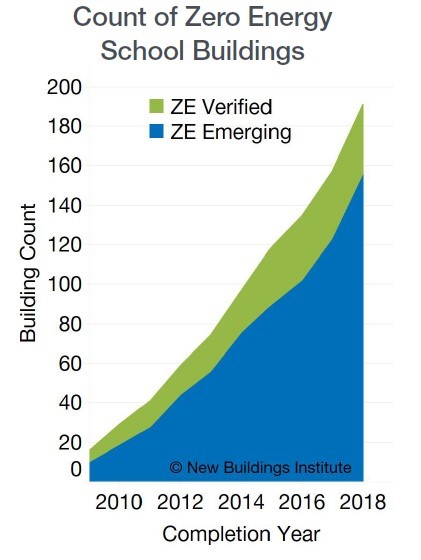Zero energy (ZE) buildings, those that use only as much energy as can be generated by clean, renewable resources, are on a solid growth path in the United States. In particular, ZE schools represent the largest segment in this market, showing a remarkable 850% growth since 2010, according to tracking by New Buildings Institute (NBI) and summarized in the recently released 2019 Zero Energy Schools Watchlist for K-12 Schools, Colleges, and Educational Projects. ZE schools have also caught the attention of Arlington County School District with its zero energy Discovery School as well as Virginia lawmakers who overwhelming passed last month Virginia HB 2192, a facilities modernization bill that includes zero energy goals and goes a step further to require excess renewable energy generation at new and renovated school sites.
Cities and states, facing mounting pressure to address carbon emissions that are fueling climate change, are increasingly turning to better efficiency and cleaner power supply in the built environment as a solution. Buildings account for nearly 40% of U.S. carbon emissions, and schools have emerged as a priority opportunity. The Virginia legislation states that “new public school buildings and facilities and improvements and renovations to existing public school buildings and facilities be designed, constructed, maintained, and operated to generate more electricity than is consumed. . .” The excess power, typically generated by solar panels, would supplant dirtier energy resource such as utility-supplied energy from coal or natural gas.
“This move by the General Assembly of Virginia can serve as a model for other states and is a much needed precedent. Zero energy schools support the education of our youngest citizens and reduce operating costs, and therefore tax burdens on communities. These zero energy buildings can also lead the transformation of the entire building sector to a positive energy future,” said NBI CEO Ralph DiNola.
In addition to carbon savings, ZE schools offer school districts and local jurisdictions a way to save on utility costs and create healthier and more productive learning environments for students and staff. Zero energy educational buildings are feasible today with 191 projects across the United States and Canada working to achieve this standard, according to the NBI Watchlist.
 The current count of schools has been driven by early adopter school districts and stakeholders that recognized the long- and short-term benefits of these buildings. A total of 35 verified and 156 emerging ZE educational buildings are located across 37 states and three Canadian provinces. NBI defines “ZE-verified buildings” as buildings with one full year of energy-use data that shows they are producing at least as much energy as is used. “ZE-emerging buildings” have a publicly stated goal of ZE, but do not yet have one full year of energy-use data. The top five states for zero energy schools are California, Kentucky, Massachusetts, Oregon and Texas, according to the NBI Watchlist.
The current count of schools has been driven by early adopter school districts and stakeholders that recognized the long- and short-term benefits of these buildings. A total of 35 verified and 156 emerging ZE educational buildings are located across 37 states and three Canadian provinces. NBI defines “ZE-verified buildings” as buildings with one full year of energy-use data that shows they are producing at least as much energy as is used. “ZE-emerging buildings” have a publicly stated goal of ZE, but do not yet have one full year of energy-use data. The top five states for zero energy schools are California, Kentucky, Massachusetts, Oregon and Texas, according to the NBI Watchlist.
To assist decision makers at all levels of government, as well as school district staff, NBI has collected some of the best examples of state and district policies and national programs working toward zero energy schools in the Getting to Zero in Schools Resource Hub. The Hub also contains research resources, feasibility studies, assessment strategies, case studies, and technical resources for zero energy school design.
“Zero energy schools present environmental, economic, and educational benefits including improved indoor air quality, higher attendance rates and teacher retention, lower maintenance costs, and more stable budgets,” said Reilly Loveland, NBI project manager. “Student engagement in zero energy schools creates hands-on opportunities for enhanced STEM education as well as life skills such as teamwork, research, time management, and the use of technology. Virginia, and other states, are leading the nation by making sure kids, coffers, and climate benefit from the kinds of schools they build,” she said.
####
About New Buildings Institute. New Buildings Institute (NBI) is a nonprofit organization driving better energy performance and lower carbon emissions from the built environment. We work collaboratively with industry market players to promote advanced design practices, innovative technologies, public policies and programs that improve energy efficiency. Learn more at newbuildingsin.wpenginepowered.com
Contact:
[email protected]
